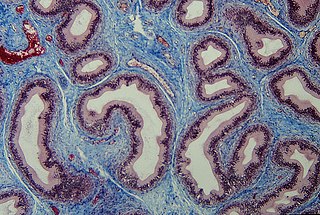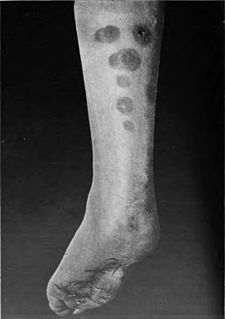
A bone is a rigid tissue that constitutes part of the skeleton in most vertebrate animals. Bones protect the various organs of the body, produce red and white blood cells, store minerals, provide structure and support for the body, and enable mobility. Bones come in a variety of shapes and sizes and have a complex internal and external structure. They are lightweight yet strong and hard, and serve multiple functions.
Collagen is the main structural protein in the extracellular matrix found in the body's various connective tissues. As the main component of connective tissue, it is the most abundant protein in mammals, making up from 25% to 35% of the whole-body protein content. Collagen consists of amino acids bound together to form a triple helix of elongated fibril known as a collagen helix. It is mostly found in connective tissue such as cartilage, bones, tendons, ligaments, and skin.

Connective tissue is one of the four basic types of animal tissue, along with epithelial tissue, muscle tissue, and nervous tissue. It develops from the mesoderm. Connective tissue is found in between other tissues everywhere in the body, including the nervous system. In the central nervous system, the three outer membranes that envelop the brain and spinal cord are composed of connective tissue. All connective tissue consists of three main components: fibers, ground substance and cells. Not all authorities include blood or lymph as connective tissue because they lack the fiber component. All are immersed in the body water. The cells of connective tissue include fibroblasts, adipocytes, macrophages, mast cells and leucocytes.

Panniculitis is a group of diseases whose hallmark is inflammation of subcutaneous adipose tissue. Symptoms include tender skin nodules, and systemic signs such as weight loss and fatigue.
Allotransplant is the transplantation of cells, tissues, or organs to a recipient from a genetically non-identical donor of the same species. The transplant is called an allograft, allogeneic transplant, or homograft. Most human tissue and organ transplants are allografts.

Fibrosis, also known as fibrotic scarring, is a pathological wound healing in which connective tissue replaces normal parenchymal tissue to the extent that it goes unchecked, leading to considerable tissue remodelling and the formation of permanent scar tissue.

The basement membrane is a thin, pliable sheet-like type of extracellular matrix, that provides cell and tissue support and acts as a platform for complex signalling. The basement membrane sits between epithelial tissues including mesothelium and endothelium, and the underlying connective tissue.
A connective tissue disease (collagenosis) is any disease that has the connective tissues of the body as a target of pathology. Connective tissue is any type of biological tissue with an extensive extracellular matrix that supports, binds together, and protects organs. These tissues form a framework, or matrix, for the body, and are composed of two major structural protein molecules: collagen and elastin. There are many different types of collagen protein in each of the body's tissues. Elastin has the capability of stretching and returning to its original length—like a spring or rubber band. Elastin is the major component of ligaments and skin. In patients with connective tissue disease, it is common for collagen and elastin to become injured by inflammation (ICT). Many connective tissue diseases feature abnormal immune system activity with inflammation in tissues as a result of an immune system that is directed against one's own body tissues (autoimmunity).
The type II and XI collagenopathies are a group of disorders that affect connective tissue, the tissue that supports the body's joints and organs. These disorders are caused by defects in type II or type XI collagen. Collagens are complex molecules that provide structure, strength, and elasticity to connective tissue. Type II and type XI collagen disorders are grouped together because both types of collagen are components of the cartilage found in joints and the spinal column, the inner ear, and the jelly-like substance that fills the eyeball. The type II and XI collagenopathies result in similar clinical features.
Achondrogenesis, type 2 results in short arms and legs, a small chest with short ribs, and underdeveloped lungs at birth. Achondrogenesis, type 2 is a subtype of collagenopathy, types II and XI. This condition is also associated with a lack of bone formation (ossification) in the spine and pelvis. Typical facial features include a prominent forehead, a small chin, and, in some cases, an opening in the roof of the mouth. The abdomen is enlarged, and affected infants often have a condition called hydrops fetalis in which excess fluid builds up in the body before birth. The skull bones may be soft, but they often appear normal on X-ray images. In contrast, bones in the spine (vertebrae) and pelvis do not harden.
The oral mucosa is the mucous membrane lining the inside of the mouth. It comprises stratified squamous epithelium, termed "oral epithelium", and an underlying connective tissue termed lamina propria. The oral cavity has sometimes been described as a mirror that reflects the health of the individual. Changes indicative of disease are seen as alterations in the oral mucosa lining the mouth, which can reveal systemic conditions, such as diabetes or vitamin deficiency, or the local effects of chronic tobacco or alcohol use. The oral mucosa tends to heal faster and with less scar formation compared to the skin. The underlying mechanism remains unknown, but research suggests that extracellular vesicles might be involved.

Collagen alpha-2(XI) chain is a protein that in humans is encoded by the COL11A2 gene.
The parametrium is the fibrous and fatty connective tissue that surrounds the uterus. This tissue separates the supravaginal portion of the cervix from the bladder. The parametrium lies in front of the cervix and extends laterally between the layers of the broad ligaments. It connects the uterus to other tissues in the pelvis. It is different from the perimetrium, which is the outermost layer of the uterus.
Scleromyositis, is an autoimmune disease. People with scleromyositis have symptoms of both systemic scleroderma and either polymyositis or dermatomyositis, and is therefore considered an overlap syndrome. Although it is a rare disease, it is one of the more common overlap syndromes seen in scleroderma patients, together with MCTD and Antisynthetase syndrome. Autoantibodies often found in these patients are the anti-PM/Scl (anti-exosome) antibodies.
An adnexal mass is a lump in tissue of the adnexa of uterus. Adnexal masses can be benign or cancerous, and they can be categorized as simple or complex. One of the most important factors used to determine the clinical suspicion of malignancy of an adnexal mass is the sonographic appearance of the mass. Indications that the mass is at a higher risk of being malignant include the presence of loculations, nodules, papillary structures, or septations or a size greater than 10 cm.

Spindle cell sarcoma is a type of connective tissue cancer in which the cells are spindle-shaped when examined under a microscope. The tumors generally begin in layers of connective tissue such as that under the skin, between muscles, and surrounding organs, and will generally start as a small lump with inflammation that grows. At first the lump will be self-contained as the tumor exists in its stage 1 state, and will not necessarily expand beyond its encapsulated form. However, it may develop cancerous processes that can only be detected through microscopic examination. As such, at this level the tumor is usually treated by excision that includes wide margins of healthy-looking tissue, followed by thorough biopsy and additional excision if necessary. The prognosis for a stage 1 tumor excision is usually fairly positive, but if the tumors progress to levels 2 and 3, prognosis is worse because tumor cells have likely spread to other locations. These locations can either be nearby tissues or system-wide locations that include the lungs, kidneys, and liver. In these cases prognosis is grim and chemotherapy and radiation are the only methods of controlling the cancer.

Scleroderma is a group of autoimmune diseases that may result in changes to the skin, blood vessels, muscles, and internal organs. The disease can be either localized to the skin or involve other organs, as well. Symptoms may include areas of thickened skin, stiffness, feeling tired, and poor blood flow to the fingers or toes with cold exposure. One form of the condition, known as CREST syndrome, classically results in calcium deposits, Raynaud's syndrome, esophageal problems, thickening of the skin of the fingers and toes, and areas of small, dilated blood vessels.

Sclerosis is the stiffening of a tissue or anatomical feature, usually caused by a replacement of the normal organ-specific tissue with connective tissue. The structure may be said to have undergone sclerotic changes or display sclerotic lesions, which refers to the process of sclerosis.
Clinical attachment loss (CAL) is the predominant clinical manifestation and determinant of periodontal disease.








